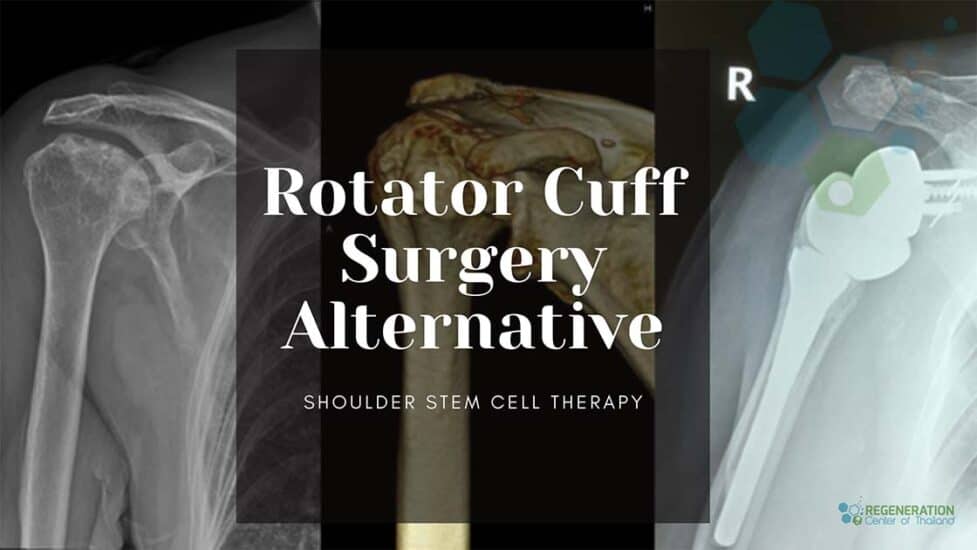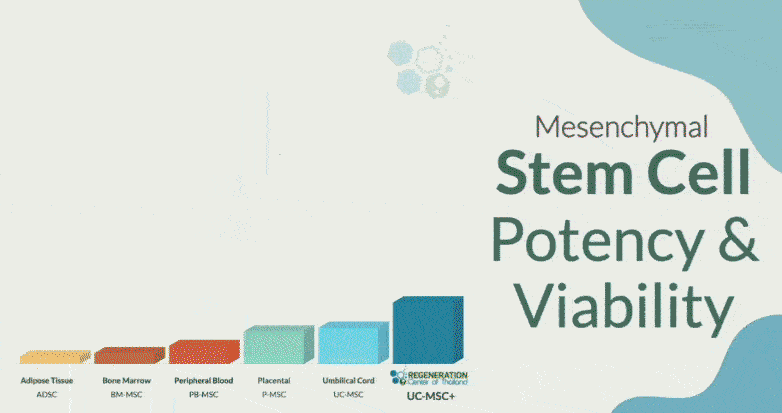Before You Risk Surgery for Rotator Cuff Injury, Take a Good Long Look at Today’s Stem Cell Therapies. The human shoulder is one of the body’s most flexible joints, but its incredible flexibility is typically why it’s so susceptible to getting a rotator cuff injury. Over the last 15 years, The Regeneration Center has developed into one of the world’s leading full-service regenerative medical treatment centers, and dealing with rotator cuff injuries due to sports or accidents are amongst the most common orthopedic joint conditions we treat.
The Shoulder Joint
Our shoulders are a complex network of muscles, tendons, ligaments, and bones. These “pulleys, levers, and scaffolding” make up the rotator cuff. When in optimal shape, the rotator cuff allows a full range of shoulder movement. However, shoulder movement becomes painful, limited, and challenging when a rotator cuff injury occurs. These injuries can happen due to acute injuries, tissue tears, or bone diseases like shoulder joint arthritis, gout, and spinal arthritis.
Why Use Surgery as a First Resort for Rotator Cuff Injury?
Many people believe that shoulder surgery is the first and only resort after suffering a rotator cuff injury. However, that isn’t true. Part of the reason for this is the undeniable advancements that have been made in virtually all types of surgical procedures. These advancements have spurred whole medical practices headed by surgeons of every kind. Many surgeons have clinics that specialize in nothing but specific joint surgeries. When doctors run facilities that depend on specialized surgery, what do you suppose they will promote as the only remedy for your rotator cuff injury?
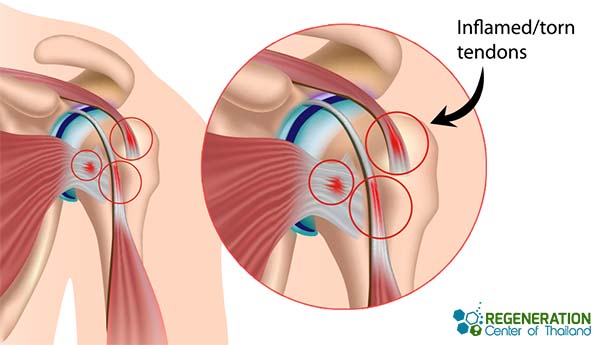
We all want to believe that our doctors and orthopedic specialists have our best interests in mind. But the reality is that institutions have been built on surgeries of every kind. Additionally, in many cases, these shoulder surgeries result in worse shoulder function than before surgery. Add to this the long, tedious, and painful process of extensive physical rehabilitation, and it’s no wonder that most people who suffer a rotator cuff injury ask if there is a reliable shoulder surgery alternative.
A Closer Look at the Risks of Surgery for Rotator Cuff Injury
Common sense tells us that “popular and frequent” is not necessarily the same as “safe and effective.” A botched surgery to repair a rotator cuff injury typically can’t be undone. Of those few failures that can be corrected, the range of motion is never the same due to the buildup of scar tissue. Too many shoulder specialists do not discuss shoulder surgery alternatives when talking with their patients. It would help to proactively research these options before risking surgery for a rotator cuff injury.
Please don’t leave it up to the surgeon to volunteer all the risks involved with surgical repair for rotator cuff injury. When consulting with specialists about surgery, have them thoroughly answer questions about the following:
Recovery Time After Shoulder Surgery
A rotator cuff injury significantly and immediately impacts the quality of life. So, you need full functionality restored as quickly as possible. This will likely not happen for at least a month with rotator cuff surgery, if not more. Standard tendon-to-bone surgical repairs target only fibro-vascular scar tissue with poor mechanical properties. A recent report in the Orthopedic Journal found that patients undergoing rotator cuff injury can expect to have the affected arm in a restrictive sling between four and seven weeks. But that’s just the beginning. Total recovery time after the surgical procedure can last as long as six months. It’s common for patients to miss weeks, if not months, of work during recovery.
Risks During & After Shoulder Surgery
The main issue with failure after rotator cuff surgery is biological. It’s well known that the delicate and highly specialized fibro-cartilaginous transition zone between the rotator cuff and the bone does not initiate regeneration after surgical repair. Regardless of the advances in shoulder arthroscopic surgery, procedures to repair a rotator cuff injury are invasive. A surgeon has to cut, sew, and displace the complex issues deep within the shoulder’s network. This leaves the patient vulnerable to various risks during the procedure itself. Some of these risks include:
- Allergic reactions to an anesthetic
- Infections
- Unintended damage to nerves & Peripheral Neuropathy
- Femoral nerve injury
- Respiratory difficulties related to anesthesia
- Major blood vessel damage causing heart disease
- Excessive bleeding
- Sarcopenia
- Irreversible tendon damage
Waiting for Failure?
It’s estimated that one in five patients who undergo shoulder surgery is likely to suffer another rotator cuff injury. That means there is a massive market for revision surgeries. The vast majority of specialists anticipate this, and they fully expect a sizable number of repairs to fail and anticipate your need for a second surgery.

Do you know what that means? Going under the knife again, enduring weeks of painful rehab again, more months of functional loss, more lost wages from absenteeism, and more medical bills that are as high or even higher than the first round.
Cost of Rotator Cuff Surgery in 2025
As of January 2023, the Healthcare Bluebook estimates the fair market price for rotator cuff injury to be between $6,750.00 and $12,900.00. When have you ever paid the lower end of any medical procedure estimate, let alone when it fell into the “fair” range? That estimate doesn’t include the overnight expenses of a hospital stay, prescription pain medication, or the physical therapy bills that follow. Imagine that you are one in five patients who experience a second rotator cuff injury. If you elect to undergo a second surgery, you’ve just doubled that number.
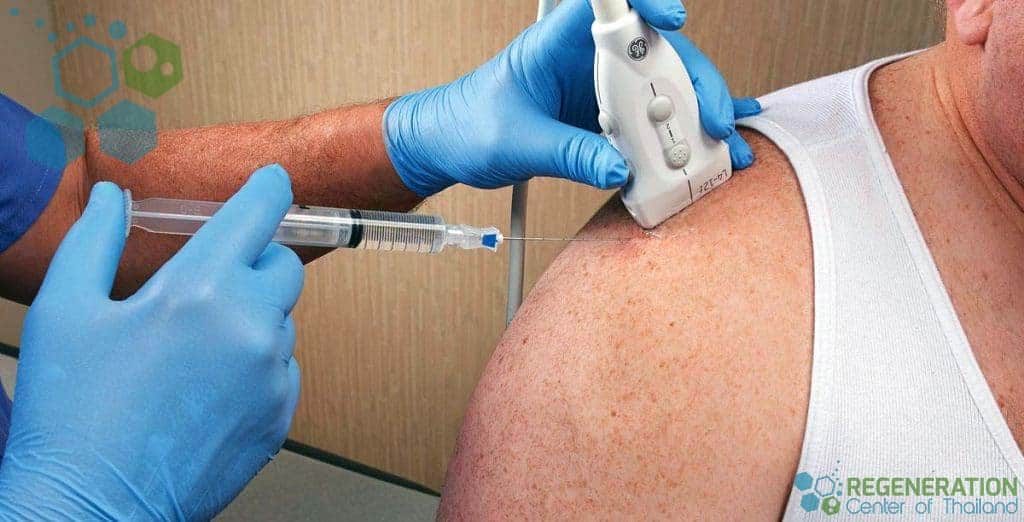
Stem Cell Rotator Cuff as a Shoulder Surgery Alternative
Enhanced stem cell therapy allows for an all-natural biological healing process due mainly to angiogenesis and its anti-inflammatory properties, enabling the regenerative cycle to begin. Of all the cell types, these specialized cells alone can become virtually any cell needed to repair disease or degeneration. Whether addressing joint problems like a shoulder joint injury, knee injuries, degenerative lumbar spine, hip injuries, or conditions like lung fibrosis, COPD, kidney failure or diabetes, senile osteoporosis, MSCs+ (modified) stem cells can be delivered into the affected area go to work rebuilding and repairing muscle, bone, cartilage, torn ligaments, and more. Today, most stem cell procedures we offer use tissue-specific stem cells and growth factors that are concentrated into therapeutic levels and then re-introduced into the diseased or injured area.
MSCs+ Stem cells maximize the body’s healing potential.
Upon infusions, the stem cells look for chemical signals to determine the area of distress and what cell types are needed for repair and regeneration, then convert themselves into those types and “home” to the injured areas of the body. The activated cells and tissue-specific growth factors also help stimulate other stem cells that may be randomly circulating near the site and promote them into becoming bone, muscle, tendon, or whatever type of tissue is needed for healing.
Isolated and Enhanced Mesenchymal stem cells (UC-MSC+) can be differentiated into different mesodermal tissues and posses a strong paracrine, immunoregulatory, anti-inflammatory and angiogenic potential. Ortho+ Stem cell therapy is thus a potentially effective non-surgical treatment to enhance rotator cuff healing.
Why is stem cell therapy for rotator cuff tears so effective?
Stem cells are essentially blank cells that our body releases every day. These circulating stem cells allow the healing process to begin. Of all the cell types, 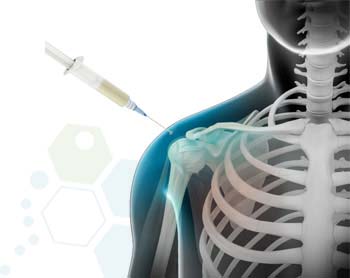 MSC+ Mesenchymal stem cells can become virtually any kind of cell needed for repairing disease or damage.
MSC+ Mesenchymal stem cells can become virtually any kind of cell needed for repairing disease or damage.
Shoulder and Joint Conditions that Can Benefit from Stem Cell Therapy
Types of injuries that benefit from stem cell therapy include:
- Tendonosis & Tendonitis
- Rotator Cuff Injury
- AC Joint Injury or Separation
- Sprains & Tears
- Thoracic Outlet Syndrome
- Shoulder Arthritis
- Recurrent Shoulder Dislocations
Shoulder Stem Cell Procedure Recovery Times
The Regeneration Center offers a multi-stage protocol over 1-2 weeks for optimal results. Our stem cell treatment for torn rotator cuff is noninvasive and done on an outpatient basis. Isolated Ortho+ MSC stem cells are the preferred type used in most procedures. These stem cells are multipotent cells that can maintain the regenerative process over multiple life cycles. Delivery of the cells is done at various points to ensure the desired cells and growth factors continue initiating the regenerative process over an extended period.
Shoulder surgery vs Stem Cell shoulder injections
Though recovery times for stem cell therapy procedures can be dramatic, it’s essential to remember that recovery length will vary according to the severity of the rotator cuff injury and the patient. The standard estimate is to expect a noticeable reduction in the injury pain within one to two months. Typically, pain reduction and improvement in function noticeably progress over six months. Compare these milder recovery issues related to stem cell therapy to those of conventional, invasive surgery.
Risks and Treatment Precautions
Of course, all medical procedures inherently carry risks, and this is true from the most straightforward procedures (like receiving a flu shot) to the most complex (like open-heart surgery). Our unique Ortho+ MSC stem cells have been developed over the last decade and present a very impressively low risk precisely because the stem cells are engineered for maximum potency with minimum surface markers to remove any chance of rejection essentially. The Regeneration Center offers Autologous cell treatments and Allogeneic Cell Therapies based on patient needs, age & severity. It can be stated with confidence that Ortho+ stem cell therapy for rotator cuff injury is safe, especially compared to far more invasive surgical procedures.
Companion Therapies to Orthopedic Stem Cell Procedures
Regenerative medicine encompasses therapeutic procedures beyond stem cell therapy. One of the most commonly used is targeted Ortho+ Stem cells, which are often used in our anti-aging and wellness protocols. Our propitiatory stem cell treatment protocols take advantage of Mesenchymal Stem cells, growth factors, and the healing powers of blood platelets according to patient needs.
Ortho+ Treatment is regularly used for musculoskeletal conditions and injuries such as:
- Osteoarthritis
- Bone fractures
- Muscle injuries
- Ligament damage due to injuries
- Tendon injuries
Ortho+ cells can be a powerful tool for natural recovery without surgery to treat a condition like a rotator cuff injury. Blood platelets contain proteins, peptides, glycoproteins, and growth factors, which dramatically boost the healing process of soft tissues such as tendons, ligaments, and even skin.
Physical Therapy & Rehab Are Essential to Long-Term Recovery.
Just as there is a recovery period after stem cell therapy for a rotator cuff injury, physical therapy is essential. Stem cells help heal and rebuild tissue, and physical therapy restores shoulder strength, mobility, and flexibility. However, you should notice a big difference between the recovery period and physical therapy phase following stem cell therapy compared to conventional, more invasive surgical practices.
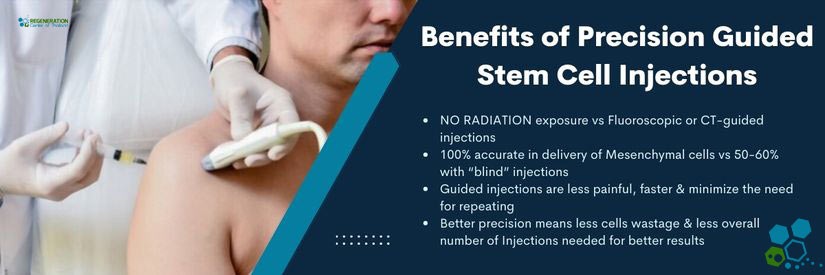
How Many Stem Cell Infusions Are Needed?
Many patients will only need a single trip to our Stem Cell Clinic for conditions like a rotator cuff injury. If there is no re-injury, Ortho+ stem cell infusions can eliminate pain restore shoulder function. However, additional stages over 1-2 weeks might be required in cases where shoulder damage is severe.
How much does stem cell treatment for rotator cuff cost?
Total treatment cost depends on the stage and severity of injury and the total number of cells needed. A recent MRI scan will be required to start an evaluation for treatment. By and large, patients will see a notable improvement starting approximately three weeks and lasting as long as 4-5 months. The stem cells need time to populate enough to begin healing and reparation. Shoulder pain will decrease dramatically over the following few months, and full mobility usually follows in short order.

Compare this to conventional, invasive shoulder surgery. Patients are often required to endure many months of grueling physical rehabilitation to regain shoulder strength and motion. With surgery for a rotator cuff injury, 4 to 6 months of recovery (2 months wearing a sling) following the surgery. Even then, many patients with shoulder surgery report that stiffness, weakness, and chronic pain remain.
Good Candidates for Rotator Cuff Regeneration
If you suffer from chronic shoulder pain of any kind, you are likely a good candidate for stem cell therapy. However, stem cell treatments may not be appropriate for all cases and injuries, as with any medical procedure.
Complete Recovery from a Rotator Cuff Injury is Possible
There’s no longer a need for someone suffering from a rotator cuff injury to rely on the hope that conventional surgery might work or run the risk of it failing to help or even possibly worsening the injury. The Regeneration Center Ortho+ Stem cell therapy has become the preferred shoulder surgery alternative. From the ranks of professional sports teams to weekend warriors to homemakers who have experienced years of wear and tear to their shoulders, Ortho+ stem cell therapy is making a natural and dramatic difference without the risks of surgery.
What to Look for in a Reputable Stem Cell Center?
When seeking a qualified stem cell therapy center, it’s important to remember that not all of them are created equal. When appropriately used, stem cells are your body’s most potent means for healing; they can repair everything from ligaments, tendons, and cartilage to organs, including your liver, pancreas, and lungs, and even neurological function like your brain neurotransmitters or damage due to spinal cord injury.
Unfortunately, most so-called “regenerative medical clinics” worldwide aren’t trained in the latest, most technologically advanced procedures and will, therefore, provide poor results, if any. Advanced stem cell and gene therapies are the most effective options for improving rotator cuff healing. The good news is that The Regeneration Centre has developed the most advanced stem cell enhanced procedures on the planet, drawing patients from all over the world and professional athletes and celebrities because they are recognized as one the best destinations for isolated & enhanced stem cell therapies (UC-MSC+).
- Highly trained and experienced, board-certified doctors and cell biologists trained to isolate + expand UC-MSC stem cells have performed stem cell procedures over 17 years with excellent results.
- Cutting-edge cell culturing procedures utilize all that regenerative medicine offers for many chronic degenerative conditions.
- Founded by leading biomedical researchers who have developed advanced cellular expansion techniques to maximize the healing potential of mesenchymal stem cells
- Use only the most potent and viable multipoint stem cells with Tissue-specific growth factors such as TGF (5–6 subtypes), Tissular cytokines, prostaglandins, Fibroblast Growth Factor (FGF), VGF, and Epidermal Growth Factor (EGF).
- Post-operative guidance supports stem cell growth, including rehabilitation, diet, and supplement protocols. The Regeneration Center is a full-service healthcare center focused on patient outcomes. Stem cell therapy is only one tool used to help improve patients’ lives.
For the last 17 years, patients from over 80 countries have placed their trust in The Regeneration Center, testifying to their level of care & unique cutting-edge stem cell procedures that have helped them experience a breakthrough when nothing else worked.

